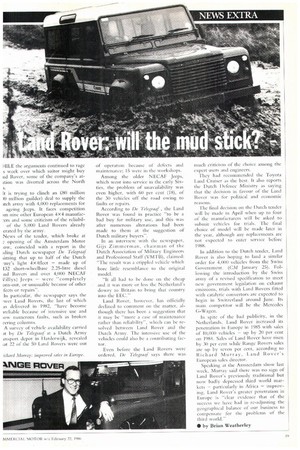HILE the arguments continued to rage s week over which
Page 19

If you've noticed an error in this article please click here to report it so we can fix it.
suitor might buy rid Rover, some of the company's atition was diverted across the North a.
It is trying to clinch an £80 million )0 million guilder) deal to supply the itch army with 4,000 replacements for -ageing Jeeps-. It faces competition itri nine other European 4x4 manufac:-ers and some criticism of the reliabil. of the 5,000 Land Rovers already erated by the army.
News of the tender, which broke at 2 opening of the Amsterdam Motor ow, coincided with a report in the ding Dutch newspaper De Telegraal liming that up to half of the Dutch 7my's light 4x4fleet — made up of 132 short-wheelbase 2.25-litre diesel .nd Rovers and over 4,000 NECAF Villys) Jeeps -were "completely orn-out, or unusuable because of other -fects or repairs".
In particular, the newspaper says the :wer Land Rovers, the last of which as delivered in 1982, "have become ireliable because of intensive use and low numerous faults, such as broken eering columns.
A survey of vehicle availability carried it by De Telegraqf at a Dutch Army ansport depot in I larderwijk, revealed ;at 22 of the 50 Land Rovers were out
of operation because of defects and maintenance; 15 were in the workshops.
Among the older NECAF Jeeps, which went into service in the early Sixties, the problem of unavailability was even higher, with 60 per cent (18), of the 30 vehicles off the road owing to faults or repairs.
According to De. Teiegraaf, , the Land Rover was found in practice "to be a bad buy for military use, and this was after numerous alterations had been made to them at the suggestion of Dutch military buyers".
In an interview with the newspaper, Gijs Zimmerman, chairman of the Dutch Association of Military Engineers and Professional Staff (VMTB), claimed: "The result was a crippled vehicle which bore little resemblance to the original model.
"It all had to be done on the cheap and it was more or less the Netherlands dowry to Britain to hring that country into the EEC."
Land Rover, however, has officially declined to comment on the matter, although there has been ;i suggestion that it may be ''more a case of maintenance rather than reliability", which can be resolved between Land Rover and the Dutch Army. The intensive use of the vehicles could also be a contributing factor.
Even before the Land Rovers were ordered, De Telegraqf says there was
much criticism of the choice among the expert users and engineers.
They had recommended the Toyota Land Cruiser as the best. It also reports the Dutch Defence Ministry as saying that the decision in favour of the Land Rover was for political and economic reasons.
The final decision on the Dutch tender will be made in April when up to four of the manufacturers will be asked to submit vehicles for trials. The final choice of model will be made later in the year, although any replacements arc not expected to enter service before 1988.
In addition to the Dutch tender, Land Rover is also hoping to land a similar order for 4,000 vehicles from the Swiss Government. (CM January 25). Following the introduction by the Swiss army of a revised specification to meet new government legislation on exhaust emissions, trials with Land Rovers fitted with catalytic convertors are expected to begin in Switzerland around June. Its main competitor will be the Mercedes (;-Wagen.
In spite of the bad publicity, in the Netherlands, Land Rover increased its penetration in Europe in 1985 with sales of 10,000 vehicles — up by 20 per cent on 1984. Sales of Land Rover have risen by 30 per cent while Range Rovers sales are up by seven per cent, according to Richard Murray, Land Rover's European sales director. Speaking at the Amsterdam show last week. Murray said there was no sign of Land Rover's previously traditional but now badly depressed third world markets — particularly in Africa — improving. Land Rover's greater penetration in Europe is "clear evidence that of the success we have had in re-adjusting the geographical balance of our business to compensate for the problems of the third world.'• • by Brian Weatherley
























































